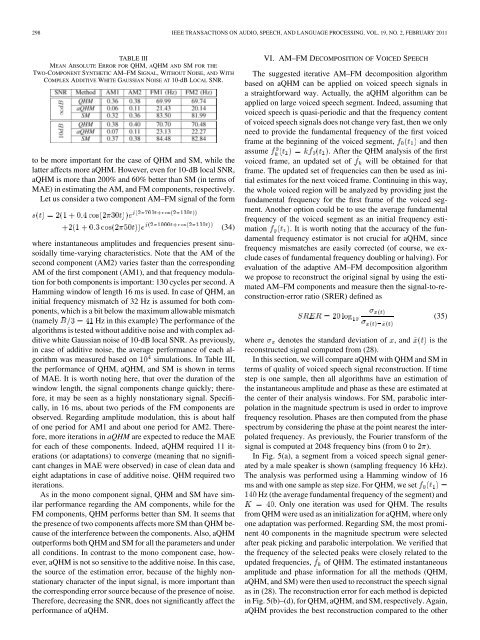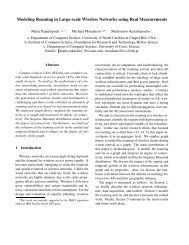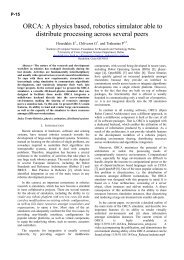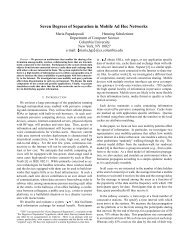Adaptive AM–FM Signal Decomposition With Application to ... - ICS
Adaptive AM–FM Signal Decomposition With Application to ... - ICS
Adaptive AM–FM Signal Decomposition With Application to ... - ICS
Create successful ePaper yourself
Turn your PDF publications into a flip-book with our unique Google optimized e-Paper software.
298 IEEE TRANSACTIONS ON AUDIO, SPEECH, AND LANGUAGE PROCESSING, VOL. 19, NO. 2, FEBRUARY 2011<br />
TABLE III<br />
MEAN ABSOLUTE ERROR FOR QHM, AQHM AND SM FOR THE<br />
TWO-COMPONENT SYNTHETIC <strong>AM–FM</strong> SIGNAL, WITHOUT NOISE, AND WITH<br />
COMPLEX ADDITIVE WHITE GAUSSIAN NOISE AT 10-dB LOCAL SNR.<br />
<strong>to</strong> be more important for the case of QHM and SM, while the<br />
latter affects more aQHM. However, even for 10-dB local SNR,<br />
aQHM is more than 200% and 60% better than SM (in terms of<br />
MAE) in estimating the AM, and FM components, respectively.<br />
Let us consider a two component <strong>AM–FM</strong> signal of the form<br />
(34)<br />
where instantaneous amplitudes and frequencies present sinusoidally<br />
time-varying characteristics. Note that the AM of the<br />
second component (AM2) varies faster than the corresponding<br />
AM of the first component (AM1), and that frequency modulation<br />
for both components is important: 130 cycles per second. A<br />
Hamming window of length 16 ms is used. In case of QHM, an<br />
initial frequency mismatch of 32 Hz is assumed for both components,<br />
which is a bit below the maximum allowable mismatch<br />
(namely Hz in this example) The performance of the<br />
algorithms is tested without additive noise and with complex additive<br />
white Gaussian noise of 10-dB local SNR. As previously,<br />
in case of additive noise, the average performance of each algorithm<br />
was measured based on simulations. In Table III,<br />
the performance of QHM, aQHM, and SM is shown in terms<br />
of MAE. It is worth noting here, that over the duration of the<br />
window length, the signal components change quickly; therefore,<br />
it may be seen as a highly nonstationary signal. Specifically,<br />
in 16 ms, about two periods of the FM components are<br />
observed. Regarding amplitude modulation, this is about half<br />
of one period for AM1 and about one period for AM2. Therefore,<br />
more iterations in aQHM are expected <strong>to</strong> reduce the MAE<br />
for each of these components. Indeed, aQHM required 11 iterations<br />
(or adaptations) <strong>to</strong> converge (meaning that no significant<br />
changes in MAE were observed) in case of clean data and<br />
eight adaptations in case of additive noise. QHM required two<br />
iterations.<br />
As in the mono component signal, QHM and SM have similar<br />
performance regarding the AM components, while for the<br />
FM components, QHM performs better than SM. It seems that<br />
the presence of two components affects more SM than QHM because<br />
of the interference between the components. Also, aQHM<br />
outperforms both QHM and SM for all the parameters and under<br />
all conditions. In contrast <strong>to</strong> the mono component case, however,<br />
aQHM is not so sensitive <strong>to</strong> the additive noise. In this case,<br />
the source of the estimation error, because of the highly nonstationary<br />
character of the input signal, is more important than<br />
the corresponding error source because of the presence of noise.<br />
Therefore, decreasing the SNR, does not significantly affect the<br />
performance of aQHM.<br />
VI. <strong>AM–FM</strong> DECOMPOSITION OF VOICED SPEECH<br />
The suggested iterative <strong>AM–FM</strong> decomposition algorithm<br />
based on aQHM can be applied on voiced speech signals in<br />
a straightforward way. Actually, the aQHM algorithm can be<br />
applied on large voiced speech segment. Indeed, assuming that<br />
voiced speech is quasi-periodic and that the frequency content<br />
of voiced speech signals does not change very fast, then we only<br />
need <strong>to</strong> provide the fundamental frequency of the first voiced<br />
frame at the beginning of the voiced segment, and then<br />
assume<br />
. After the QHM analysis of the first<br />
voiced frame, an updated set of will be obtained for that<br />
frame. The updated set of frequencies can then be used as initial<br />
estimates for the next voiced frame. Continuing in this way,<br />
the whole voiced region will be analyzed by providing just the<br />
fundamental frequency for the first frame of the voiced segment.<br />
Another option could be <strong>to</strong> use the average fundamental<br />
frequency of the voiced segment as an initial frequency estimation<br />
. It is worth noting that the accuracy of the fundamental<br />
frequency estima<strong>to</strong>r is not crucial for aQHM, since<br />
frequency mismatches are easily corrected (of course, we exclude<br />
cases of fundamental frequency doubling or halving). For<br />
evaluation of the adaptive <strong>AM–FM</strong> decomposition algorithm<br />
we propose <strong>to</strong> reconstruct the original signal by using the estimated<br />
<strong>AM–FM</strong> components and measure then the signal-<strong>to</strong>-reconstruction-error<br />
ratio (SRER) defined as<br />
(35)<br />
where denotes the standard deviation of , and is the<br />
reconstructed signal computed from (28).<br />
In this section, we will compare aQHM with QHM and SM in<br />
terms of quality of voiced speech signal reconstruction. If time<br />
step is one sample, then all algorithms have an estimation of<br />
the instantaneous amplitude and phase as these are estimated at<br />
the center of their analysis windows. For SM, parabolic interpolation<br />
in the magnitude spectrum is used in order <strong>to</strong> improve<br />
frequency resolution. Phases are then computed from the phase<br />
spectrum by considering the phase at the point nearest the interpolated<br />
frequency. As previously, the Fourier transform of the<br />
signal is computed at 2048 frequency bins (from 0 <strong>to</strong> ).<br />
In Fig. 5(a), a segment from a voiced speech signal generated<br />
by a male speaker is shown (sampling frequency 16 kHz).<br />
The analysis was performed using a Hamming window of 16<br />
ms and with one sample as step size. For QHM, we set<br />
Hz (the average fundamental frequency of the segment) and<br />
. Only one iteration was used for QHM. The results<br />
from QHM were used as an initialization for aQHM, where only<br />
one adaptation was performed. Regarding SM, the most prominent<br />
40 components in the magnitude spectrum were selected<br />
after peak picking and parabolic interpolation. We verified that<br />
the frequency of the selected peaks were closely related <strong>to</strong> the<br />
updated frequencies, of QHM. The estimated instantaneous<br />
amplitude and phase information for all the methods (QHM,<br />
aQHM, and SM) were then used <strong>to</strong> reconstruct the speech signal<br />
as in (28). The reconstruction error for each method is depicted<br />
in Fig. 5(b)–(d), for QHM, aQHM, and SM, respectively. Again,<br />
aQHM provides the best reconstruction compared <strong>to</strong> the other
















